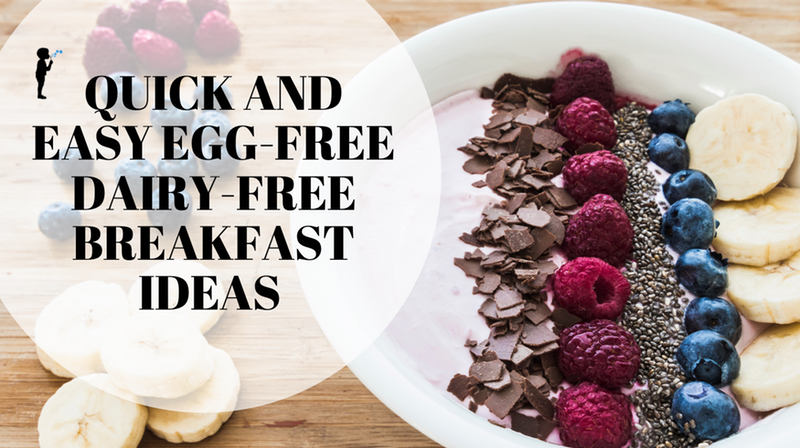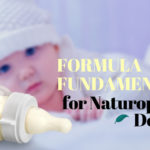
Quick and Easy Egg-Free Dairy-Free Breakfast Ideas!
As a naturopathic doctor specializing in pediatrics, I run a lot of food panels that test for food sensitivities. Why? Because I know that health starts with food, first and foremost, and more times than not, the symptoms I see most commonly arise because of an imbalance in the gut. Kids are notorious for having positive results show on their food sensitivity panels for dairy and eggs. I see both dairy and eggs come up elevated for sensitivity in as many as 7 out of every 10 symptomatic kiddos I run panels on. What symptoms, you ask? It can vary, and most commonly I run panels on children who experience abdominal pain or bowel habit challenges, behavioral issues, and skin illnesses like eczema or other rashes. Although these foods are common in our culture, a very healthy and satisfying diet can still be crafted without them. It may be simple and easy to convert over commonly eaten foods for some families, and more difficult for others. In this article, we explore why this is important, how to go about replacing eggs and dairy products in your child’s diet, and what egg-free dairy-free recipes I use often at my own house.
What is a food sensitivity? Is it the same as a food allergy?
Great questions! This is well discussed in a prior article that I highly suggest you check out for full understanding. The gist of this difference is that food sensitivities are delayed and often trigger body-wide reactions (eczema, bowel changes, dark circles under the eyes, behavioral issues) to foods that are mediated through the IgG immune pathway, while food allergies cause obvious immediate reactions (hives, swelling, anaphylaxis) and are mediated through the IgE immune pathway.
Children with IgE reactions to certain foods will need to avoid those foods entirely, as this is a life-threatening condition. Children with IgG reactions to food may not know exactly what foods are causing the symptoms they experience until a food panel is run. Even though your child may not have an outright IgE reaction to a certain food, such as dairy or eggs, if they have a moderate to high IgG reaction, I still recommend avoiding these foods for at least 8 weeks while we give the gut a break and time to rebuild and heal. What happens with an egg allergy, for example, is that your child’s immune system becomes sensitized and overreacts to the proteins in egg whites or egg yolks. Then, when eggs are eaten again, the body sees those proteins as foreign invaders and sends out chemicals to defend against them. Those chemicals are what cause symptoms of inflammation and allergy in the body. Our goal is to decrease the chemical release so your body can rest and repair, and one day your child may be able to eat these foods once again.
How do I replace eggs and dairy, such common breakfast foods, in my child’s diet?
Most commonly, it’s the child’s breakfast that contains either eggs or dairy, and sometimes both. At the end of this section you can find several ideas for nutrient dense and egg-free dairy-free breakfast ideas your kiddo will surely love. Breakfast is one of the most important meals of the day for your growing child, and it’s important that we capitalize on their hungry post-sleep appetites in this meal to set them up for a day of consistent energy and nutrition. The nutrients that get absorbed through breakfast (and every meal) will help your child’s mind and attention span be able to focus and learn as much as possible from each opportunity in the day, as well as provide for all of the energy-demanding metabolic processes that are required for healthy growth.
The most common breakfast in the US today are sugary cereals. This supplies the body with zero nutrition and in fact does more harm than good by raising blood sugar quickly and increasing oxidative stress and inflammation in the body. Within minutes, the high blood sugar levels will suddenly plummet below baseline, leading to hypoglycemia and an intense desire for more sugary foods to raise the levels back up – and the cycle has begun. This causes irritability, fatigue and may lead to misbehaving. (For more information check out How to improve your child’s behavior with blood sugar control) Thus, when nutrient-lacking and high-sugar foods are provided as breakfast, the body is forced to direct energy towards self-healing rather than playing, socializing, or enjoying school. Although eggs and dairy themselves may not be full of sugar, to a child with egg or dairy food sensitivities, the same oxidative stressors and inflammation cascades are triggered, resulting in a similar outcome. Simply avoiding foods that your child reacts to can have a significant and profound effect on their mood, abilities, and overall health.
Go ahead and give one or all of these recipes a try. It can be slow process re-learning how to cook and getting out of old eating patterns. Be patient with yourself, and know that you’re doing the best for your child by providing a nutrient-dense meal for each breakfast. Cheers to nourishing foods first thing in the morning!
Dr. Roumell’s Famous Oatmeal:
I never thought so many people would love this oatmeal recipe. I have patients who will eat this EVERY single morning, and although I do advocate for food variety, it’s ok to fall into patterns for short periods of time. We personally do not eat it every morning at my house, but it’s a solid favorite – especially for my daughter who absolutely devours it.
Why is this different than regular oatmeal?
Oatmeal on its own is a healthy form of carbohydrate, but it can be a bit too high in carbohydrates, which increases your insulin levels and leads to elevated blood sugar that sets you up to have an energy crash about one hour after eating. Most people add additional sugar to oatmeal, like brown sugar or maple syrup, which adds to the total carbohydrate load. This recipe is different because it incorporates a healthy protein and nutrient-dense fat along with the carbohydrate, making for a delicious and almost-balanced meal! Why do I say “almost-balanced?” Because it’s missing a vegetable! I often eat this oatmeal alongside a small green juice or smoothie to make up for its lack in vegetables, or just skip them all together for now and add more at lunch. Get creative!
Ready?
Ingredients:
½ cup rolled oats *refer to this list to ensure you are buying glyphosate free oats.
1 cup filtered water
2 scoops plain collagen powder (I like Vital Proteins) *1 scoop for a child less than 12 years of age
1-2 tablespoons ghee (if tolerated), or butter-alternative
Generous amount of sea salt (to taste)
Directions:
Cook the rolled oats with water on the stove, as per directions on the label. One serving is about ½ cup of oats to 1 cup of water. (I never measure – just add enough water for the consistency you like. If you like it runny, add more water. If you like thicker, add less).
While the oats are cooking, add 2 scoops of Vital Proteins collagen powder to an empty bowl. Add 1 tablespoon of ghee or butter alternative to the bowl as well. Once the oats are cooked, add them to the bowl as well, on top of the powder/butter combo – but read the method below very carefully!
***Here is the big trick***
Don’t just start stirring! The collagen will get congealed and the texture will get sticky with all that gelatin. I’ve learned that in order to get the collagen mixed in completely, smoothly, and deliciously, it requires a special folding motion to prevent the congealing. You can either use your imaginations and good ‘ol trial and error, or you can check out the Instagram video I made (@DrElanaRoumell) on July 27th, 2018th for the precise method!
Now, add sea salt. Yep, that’s right! I LOVE sea salt so I add a good amount. Everyone has a preference to taste, so add however much you want. Some kids like oatmeal on the sweeter side, so you can add a natural sweetener like fresh fruit or even a small amount of high quality maple syrup or honey*. I personally love it with that savory, fatty, salty taste.
*Remember: honey is not to be given to infants under 12 months of age due to a risk of serious illness from botulism toxicity.
Smoothie Bowl:
A smoothie bowl is basically a blended smoothie, in a bowl, with additional toppings so that it’s eaten like a yogurt with granola bowl, only without dairy!
Smoothie:
Here is a outline of what to put into your blender to get the most nutrient packed meal:
Healthy protein: My favorite is, again, the Vital Proteins collagen powder. It is unflavored, so you can add it to virtually anything and reap the benefits of high quality protein without a gritty texture. If you want a flavored collagen protein, I like the Pure Paleo Protein by Designs For Health.
Healthy fat: I like to rotate different fats in each smoothie. Choose one of the following, or combine some to make a creamy and satisfying smoothie! Hemp seeds, chia seeds, flax seeds, almond butter, peanut butter, tahini, Nutzzo, avocado, full fat coconut milk, coconut flakes, coconut butter, etc. The choices are endless!
Leafy greens: This can mean fresh greens, frozen greens or a greens powder. I tend to mix it up based on what I have on hand – spinach, kale, or a power greens mix are common in my house. Green powders are packed full of a variety of greens, as well. One of my favorite brands is Healthforce’s Vitamineral or Allergy Research Group’s Progreens, but there are many on the market to choose from.
Fruit: Organic berries are my favorite! Berries are low in sugar and packed full of antioxidants. Bananas add creaminess, tropical fruits add sweetness, apples add a frothy texture your kiddo may just love. Mangos, figs, dates – whatever you have in the house! Again, the possibilities are endless!
Liquid: Filtered water or a non-dairy nut milk are great options. Stay away from juice if you can, as there is already sugar from the fruit in this meal and we don’t want to overload your child. If you want to try and spice it up, you can add a variety of items such as: cocoa nibs, cinnamon, fresh mint, goji berries, etc!
Toppings:
Once the smoothie has been blended well, pour it into a bowl and top with some delicious and aesthetically-pleasing healthful foods. I like to use cocao nibs or coconut flakes for crunch, hemp seeds for a nutty flare and extra protein, or sliced fruit like banana and strawberries because it looks amazing and my daughter loves them. Tailor your smoothie bowls to your child’s tastes, and don’t forget to get creative!
Bacon Avocado Sausage Wrap
This is just what it sounds like, and is maybe better for older children who can hold a wrap in their hands. Or, you can skip the wrap and place the contents in a bowl for your younger child. Packed full of protein and fat, this is an excellent meal to start the day for long-lasting energy! Mix avocado, cooked nitrite-free bacon, and pastured chicken or pork sausage into a coconut or cassava-flour wrap, and enjoy! You can experiment with flavors by adding avocado-mayo, tahini, cashew cream sauces, or salsa for more kick! *My absolute favorite wraps are the Thrive Market brand coconut wraps. We don’t just eat these as wraps in our household but also use them as mess-free snacks for kids! Thrive Market is my number one go to place for online discounted healthy foods.
Chia Seed Pudding:
Chia seeds are full of protein, fiber, and omega-3’s making them an excellent super food to eat many times per week. Chia seed pudding needs to be made at least 4 hours prior to consumption, so this is a great meal to make the night before.
As a base recipe:
-Mix ½ cup of chia seeds and 2 scoops of a collagen or protein powder into 2 cups of unsweetened non-dairy nut milk. I use coconut milk and Vital Proteins collagen powder personally, but there are many options to choose from. Stir well, and store in the refrigerator in a covered glass container. In the morning, scoop out your desired portion into a bowl and top it with fresh fruit and enjoy!
To add to the base recipe include a mix and match of any of the following:
-Hemp seeds, flax seeds, pumpkin seeds, coconut flakes, cocoa nibs, a nut butter and/or various spices.
Protein Rich Paleo Granola:
If your kids just can’t get over their cereal addiction, a great substitute is this protein-rich granola cereal. You’ll notice a theme here, too, which is that I find it a simply healthy addition to include extra protein in many of these protein-deficient meals!
So, for this recipe, simply take a non-dairy unsweetened nut milk (hemp, coconut or almond) and mix it with 2 scoops of a non-flavored protein powder (my favorite is Vital Proteins Collagen), and mix it up well into the milk until dissolved. Pour this milk/protein mix over a paleo granola and serve! The purpose of finding a granola that is labeled as “paleo” is that you can now be sure it is free of added or refined sugars and processed vegetable oils. Thankfully, this is a very common product at most health food stores, Thrive Market and even Costco!
Paleo Protein Muffins
For quick, easy and nutrient dense muffins, I like to recommend the brand Simple Mills. They have a variety of flavors like banana, pumpkin, vanilla and chocolate, all made with almond flour, and all are delicious! Follow the recipe on the box and add a few scoops of a protein powder to the mix for added nutrition. Also, they provide a great chart that gives ideas on egg replacers you can use with their mixes. Here is the link for more their detailed chart.
Removing eggs and dairy from your child’s daily menu doesn’t need to be complicated or elaborate. Thankfully, there are abundant online resources to help further guide you with recipes ideas and substitutions for any situation. Happy eating!
If you are not already a member of Thrive Market I highly recommend it as an affordable place to find many of the ingredients I list above! Disclaimer: This is an affiliate link where you will get 25% off your first order!
*For more recipe ideas to feed your little one visit my Instagram @DrElanaRoumell



